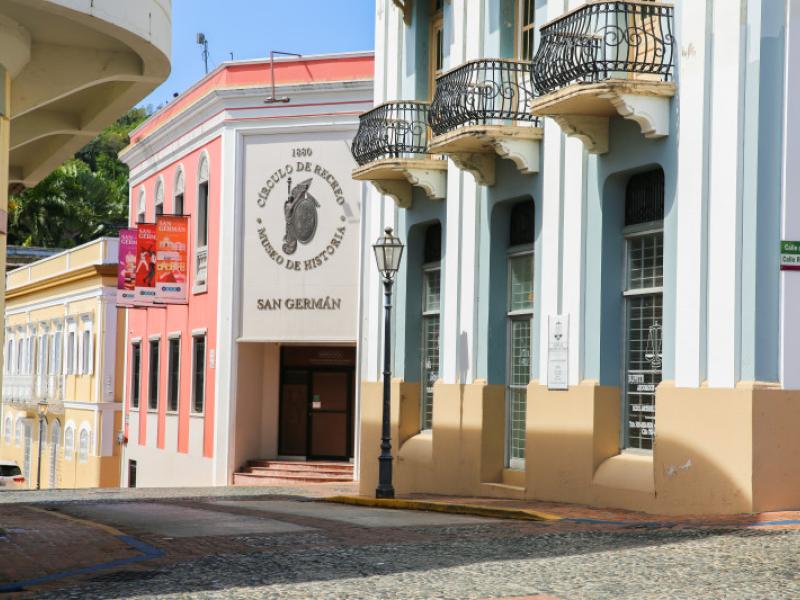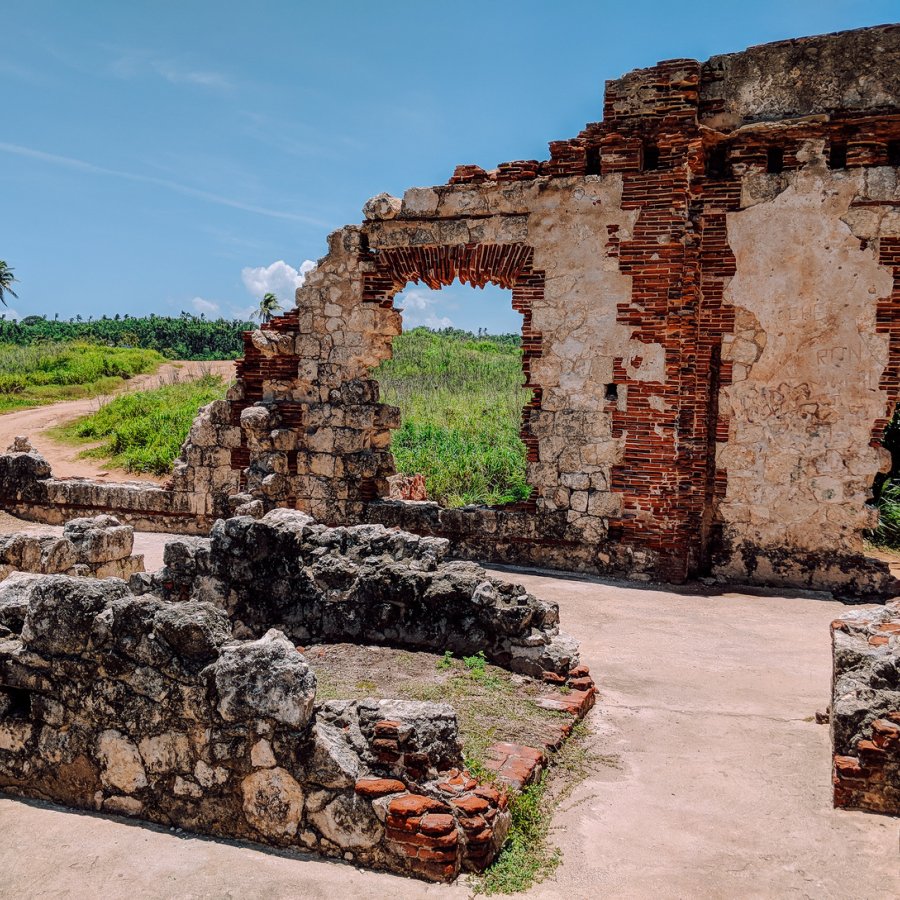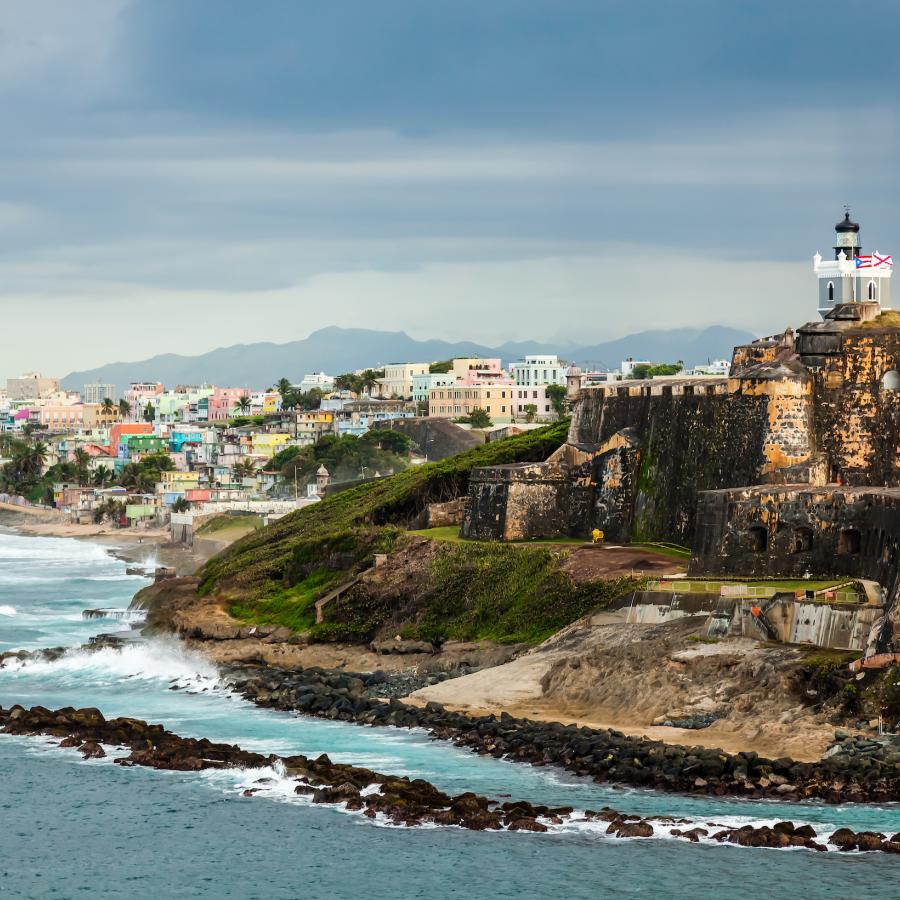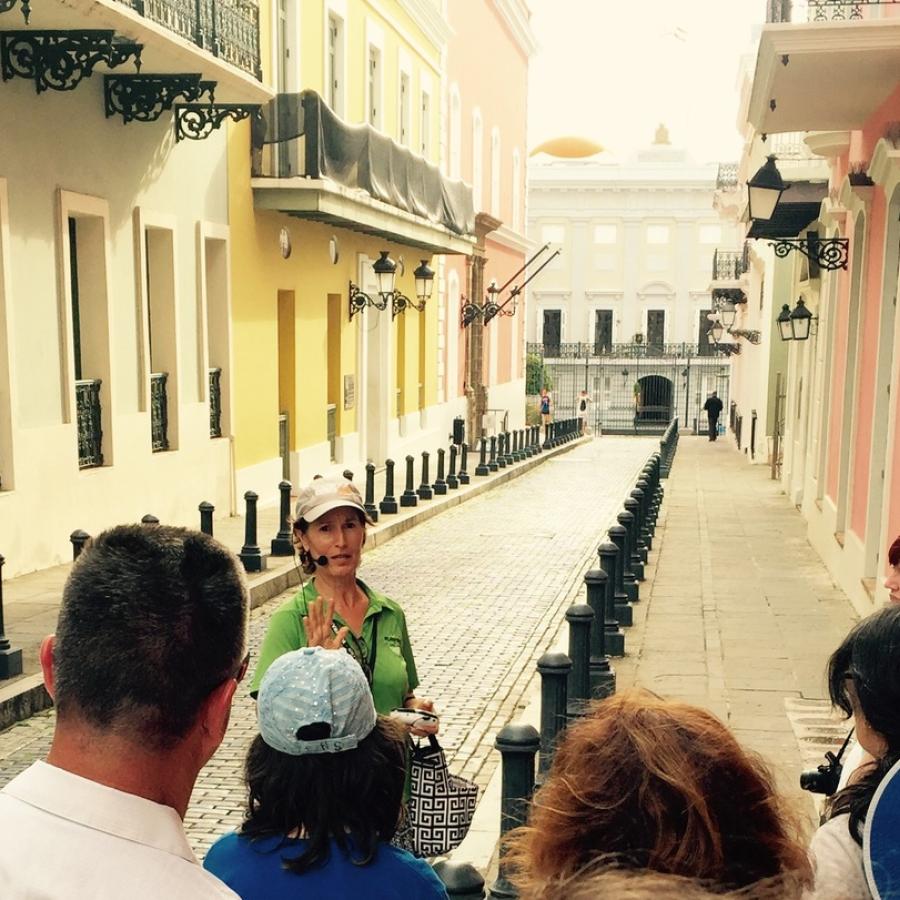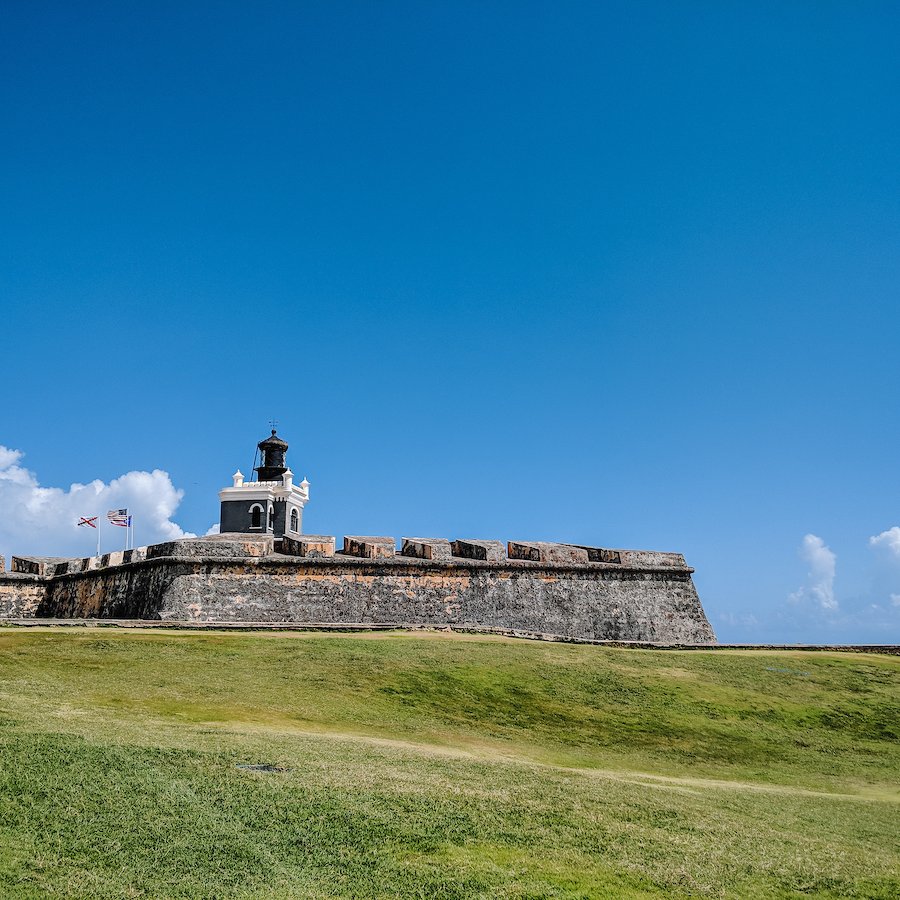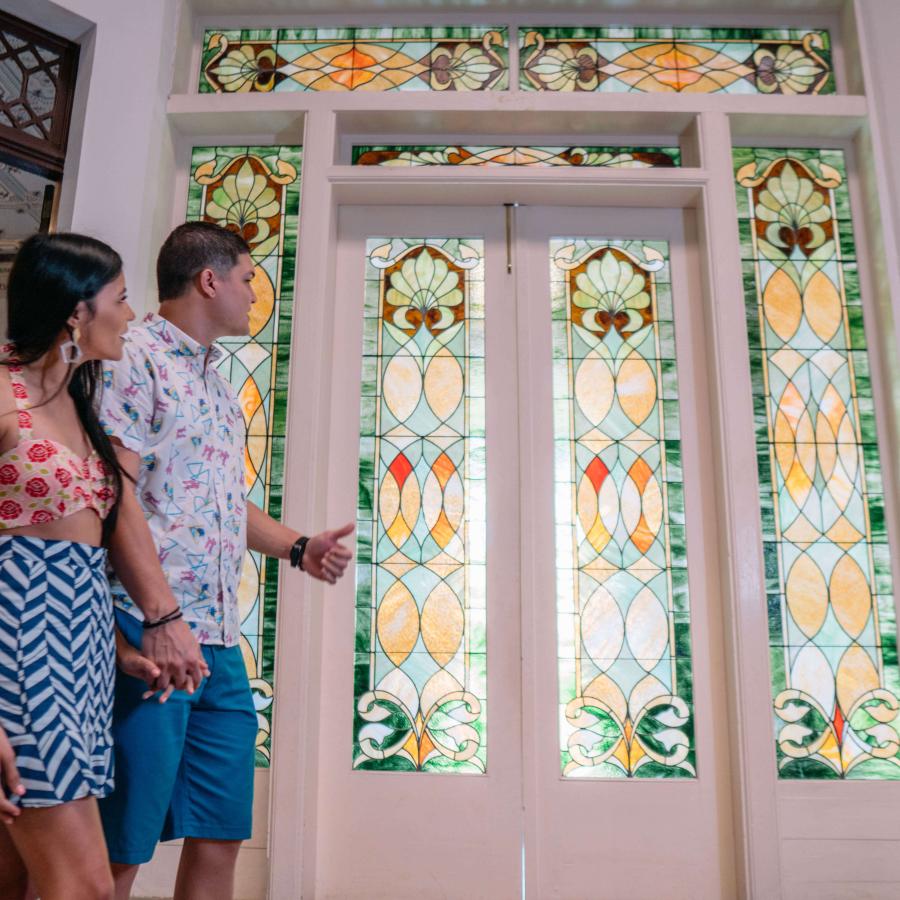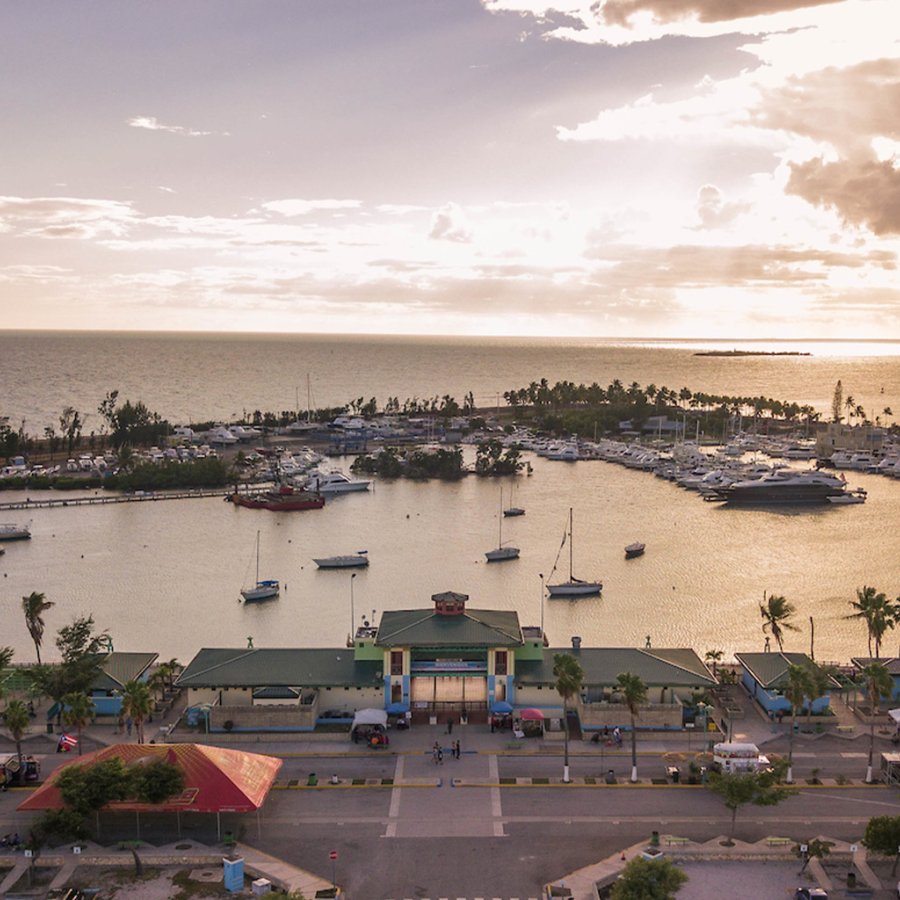Dive into the history and enchantment of the structures that built us.
There is a reason Puerto Rico is the heart and soul of the Caribbean. It is well known that its pristine beaches, mesmerizing mountainous landscape, delicious food, and the never-seizing energy of its people make the Island the ideal destination for just about any traveler seeking a paradise getaway. But did you know that Puerto Rico’s larger-than-life architecture is as varied as its natural resources?
The prominent buildings are shaped by diverse cultural and artistic influences, ranging from Neoclassical, Gothic, Baroque, Colonial, and more. San Juan alone is home to over 400 historical buildings. More are scattered across the Island, depicting an era in which Spaniards, Taínos, and Africans roamed these lands, and French, Dutch Irish, and more settled across this Caribbean gem.
Visit historical sites that served as old military bases and barracks. Tour private residences that are the epitome of Art Deco in Puerto Rico or go down under centennial tunnels that connect towns underground. You can also visit the oldest churches in the Americas and explore castles, estates, and more.
So, start planning your getaway and explore the magic of Puerto Rico’s architectural value.
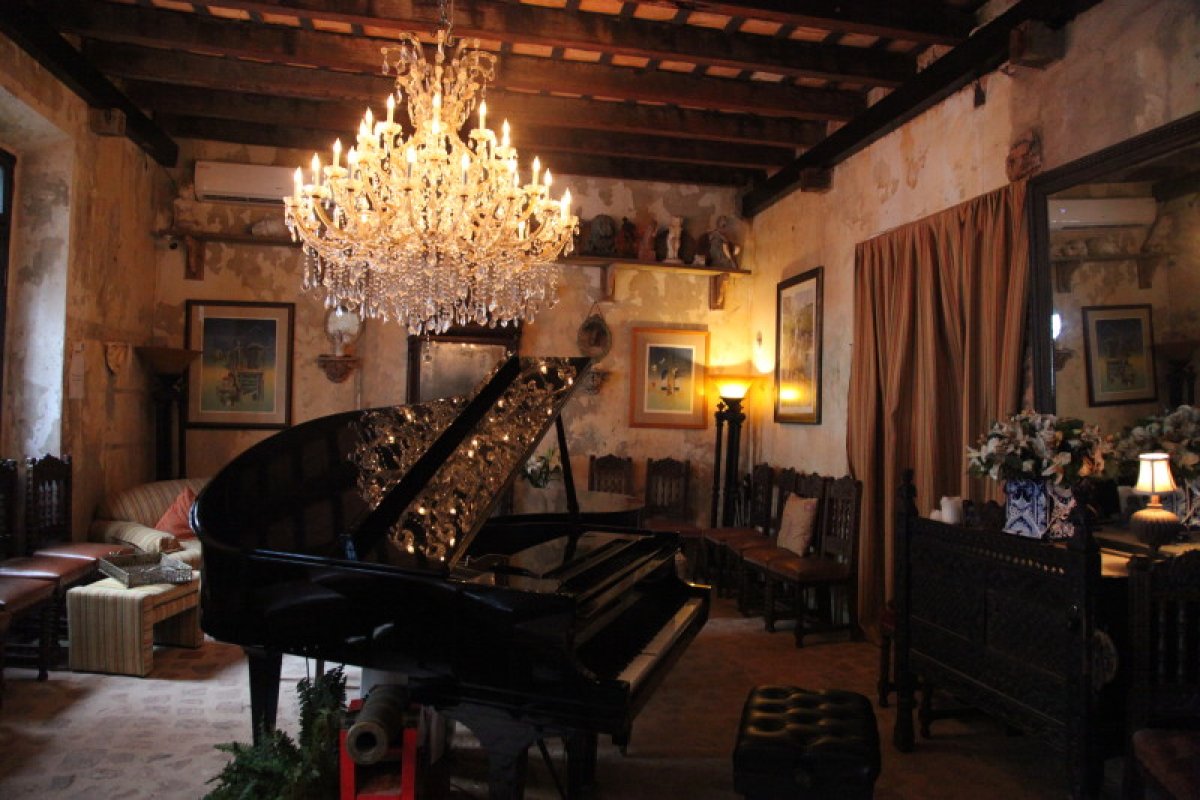
The Gallery Inn is a stunning 27-room boutique hotel in Old San Juan.
Day One: Fall under the spell of The Gallery Inn
Your first stop in your architectural immersion needs to be The Gallery Inn. Spend a night (or two) at this magical place hidden away in the corner of Norzagaray street in Old San Juan. From the moment you step into this piece of history, you'll feel the wonder and enchantment of the ancient structures, and believe us when we say; you'll fall trapped to the magic this small hotel entices. As soon as you step in, your architectural journey begins! Endemic plants and flowers glamour up the entrance patio, and the owners' parrots and cockatoos will receive you. Campeche, the oldest bird in the estate (yes, he's a 24-year-old white cockatoo), will be the main attraction, so be sure to snap a pic with him or record him singing later in the night.
The Gallery Inn is the place where different worlds collide, as it conserves the beauty and sophistication of the old-world in all its glory. From sculptures to paintings, music, and nature, it seems like every aspect of yesteryear is enhanced at this 22,000 square feet property. This spectacle of a place has around 27 boutique rooms and 360-degree rooftop terrace views of the walled city. As you tour the property, you'll notice its 15 patios and terraces where you can sit down, enjoy the artistic surroundings, and take the most stunning photographs you can think of.
Take some time to ask about the history of the place, especially if you see Jan D'Esopo strolling around the property. The 87-year-old lady is the sole owner and original builder of the hotel, and she lives there. Relish in her stories, as she'll tell you all about her husband, her love for the Island, as well as how the father of modern Puerto Rican archeology, Don Ricardo Alegría himself, pointed her to the building that now houses the small inn. You can also hear her impeccable singing voice at dinner at the iconic Cannon Club, the hotel's on-site fine dining restaurant. Then, walk around and learn all about the 1800's brick patios, antique arches, sculptured fountains, and faucets, as well as the ausubo beams that hold the place together. The rooms are scattered through side-by-side levels that'll make you feel like you're in an ancient castle's labyrinth exploring the museum-like art.
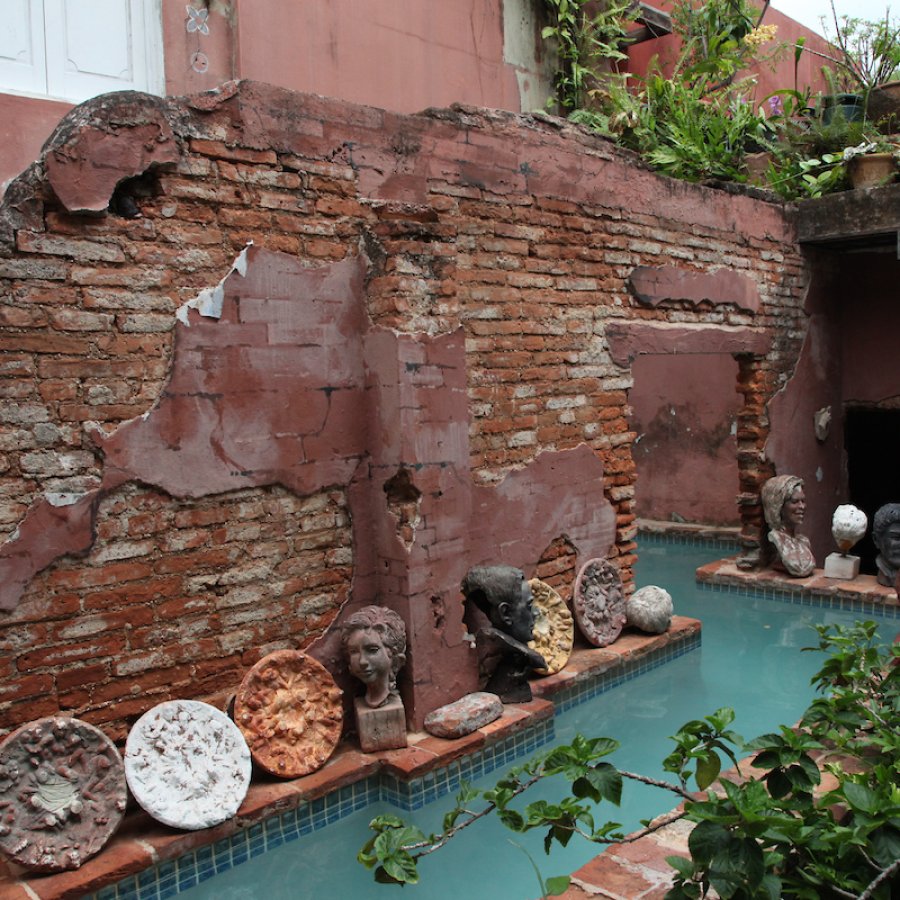
The pool at Gallery Inn in San Juan is one-of-a-kind.
A piece of the building's history-turned-art that you cannot miss is the iconic fountains in the sunken garden (by the restaurant's entrance) that make up the pool. This two-waterfall working swimming pool was built around the original walls and doorways to preserve the authenticity and integrity of the building.
As if the walls and doorways of this stunning gem weren't telling enough of D'Esopo's love and dedication to art and historical conservation, the Gallery Inn hosts The Steinway Society. This elite music society hosts a series of concerts featuring internationally renowned pianists at the Music Room. You can also catch jazz or blues live shows while having dinner or a cocktail at the Cannon Club and Steinway Piano Bar.
After dinner, find a cozy corner to read a book, journal your travels, or keep strolling and be connected room after room after next.
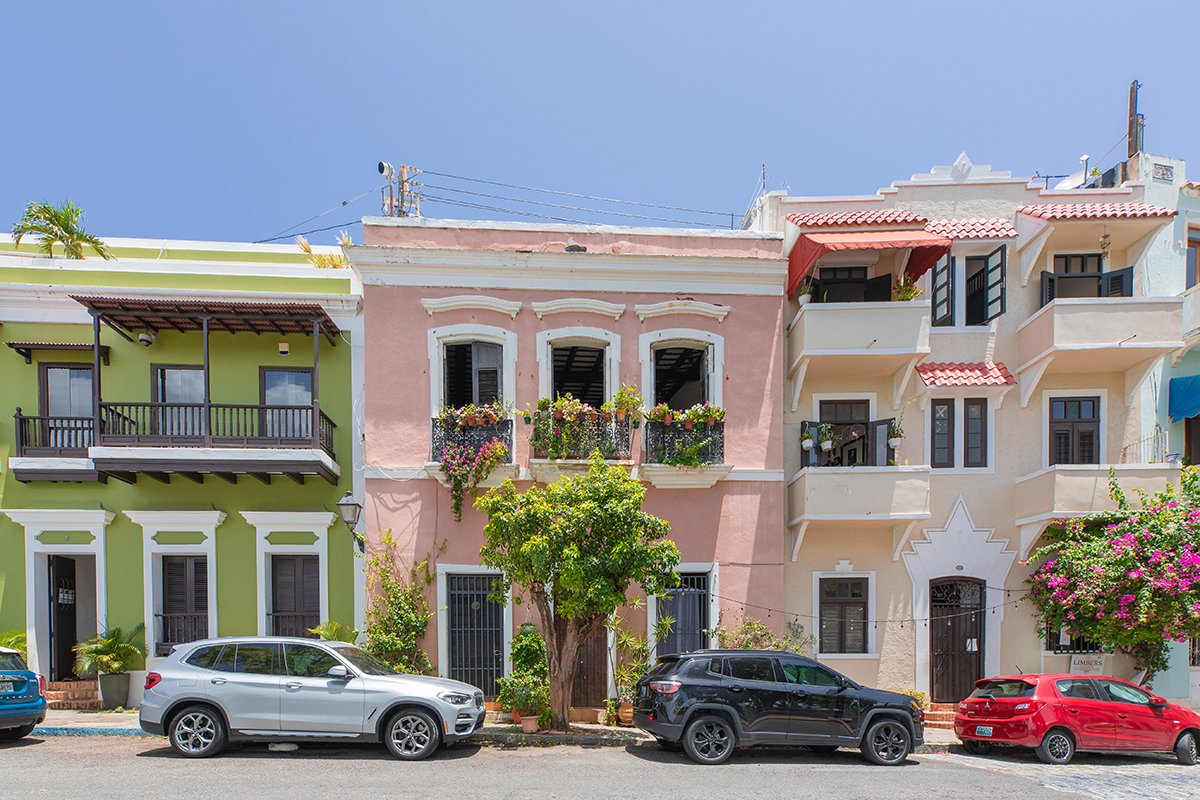
View of 16th-century houses in Old San Juan.
Day Two: Explore Old San Juan through an architect’s eye
Yes, you're in Old San Juan, the second-oldest city founded by Europe in the Americas, which means they'll be a lot of impressive colonial architecture to explore. If you haven't been curious already, the first things you'll notice are the cobblestone streets and their peculiar blue-gray color. They serve as the first indicator of olden-day pavements, as the bricks were imported from Liverpool, England. Before they were implemented in 1883 and 1890, the streets of Old San Juan were paved by river stones. So, let them be your pathway into an exciting sighting of engineered gems.
Start your morning with coffee and breakfast at Café Don Ruiz at El Cuartel de Ballajá for an example of how the new world collides with the old. The old barrack that now houses the Museo de las Américas will capture your eye for its open-plaza grounds. You'll notice new businesses like Don Ruiz are nestled in the lower rooms of the barracks, as well as CinemaBar and other restaurants, but the 1800's building keeps its original façade.
Continue to Castillo San Felipe del Morro and the Fuerte San Cristóbal, two of the oldest (and most prominent) fortifications you’ll notice in the area. The towering fortresses were built over 250 years served as protection from numerous pirate attacks and other countries' invasions. They remain undefeated.
And, learning about architecture comes hand in hand with learning about history, and Puerto Rico is rooted in Catholicism. As a result, there are many churches and chapels to explore that are very distinct from the era where they were built. For example, the San Juan Cathedral was initially built in 1521 made of wood and straw, and after long pauses in construction, it was finished by the 19th century. You’ll notice the gothic-style ceilings belonging to the sections of the church. If you tour with a tour guide from the municipality, they might take you to the eldest’s parts of the church – which include a staircase that leads to one of the most stunning views of the city, The remains of Juan Ponce de León, the Island's first governor; and Juan Alejo Arizmendi’s, the first Puerto Rican bishop, rest forever in peace at this church.
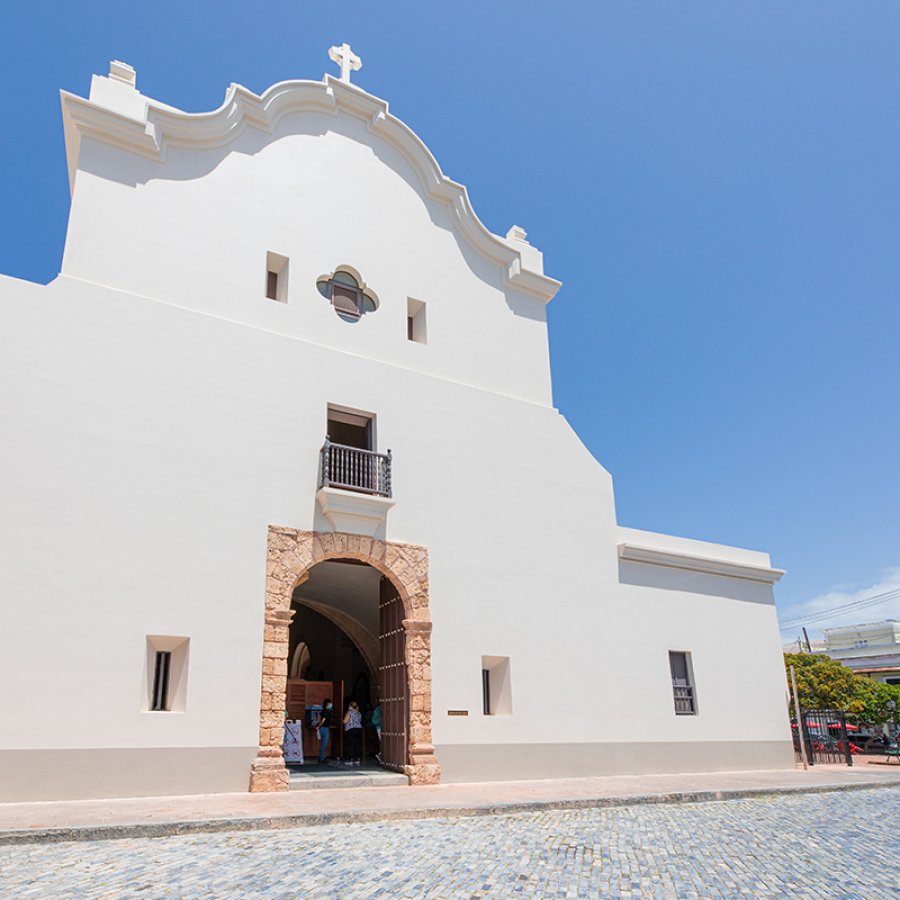
The San José Church in Old San Juan, one of the oldest churches in America.
Built from 1530 to 1775, what is known now as the San José Church was the Saint Thomas Church. In 1858 the church was given to the order of the Dominican Jesuits, who gave it its current name, and eventually, the Paul order turned it into a parish in 1908. What you'll be introduced to now as the San Francisco Church in San Juan is the Capilla Franciscana, built-in 1756 and rebuilt by 1779 by the Saint Francis order in Puerto Rico. You'll notice many other chapels and buildings that belonged to the Catholic church along the streets and near the plazas of San Juan. Keep an eye out for their gothic and colonial design.
And, even if you'll pass by iconic landmarks of Old San Juan, the real beauty lies in its buildings.
Pass by La Casa de los Contrafuertes, a residence with buttress characteristics and one of the oldest residences in the city. Today, it is home to the Museo de la Raíz Africana, dedicated to educating about the influence of West African cultures in Puerto Rico. Another residential building that houses a museum is Casa Blanca, the home constructed in 1525 for Ponce de León's family – and later was the home of Commander Brooke.
As you keep walking around the cobblestone streets, you'll notice the impressive Muralla de San Juan, a three-mile-long wall that boards all the old city. Its construction started in 1634 as a response to attacks in the late 1500s. In the late 1800s, the east and south sections of the wall were destroyed to expand the city.
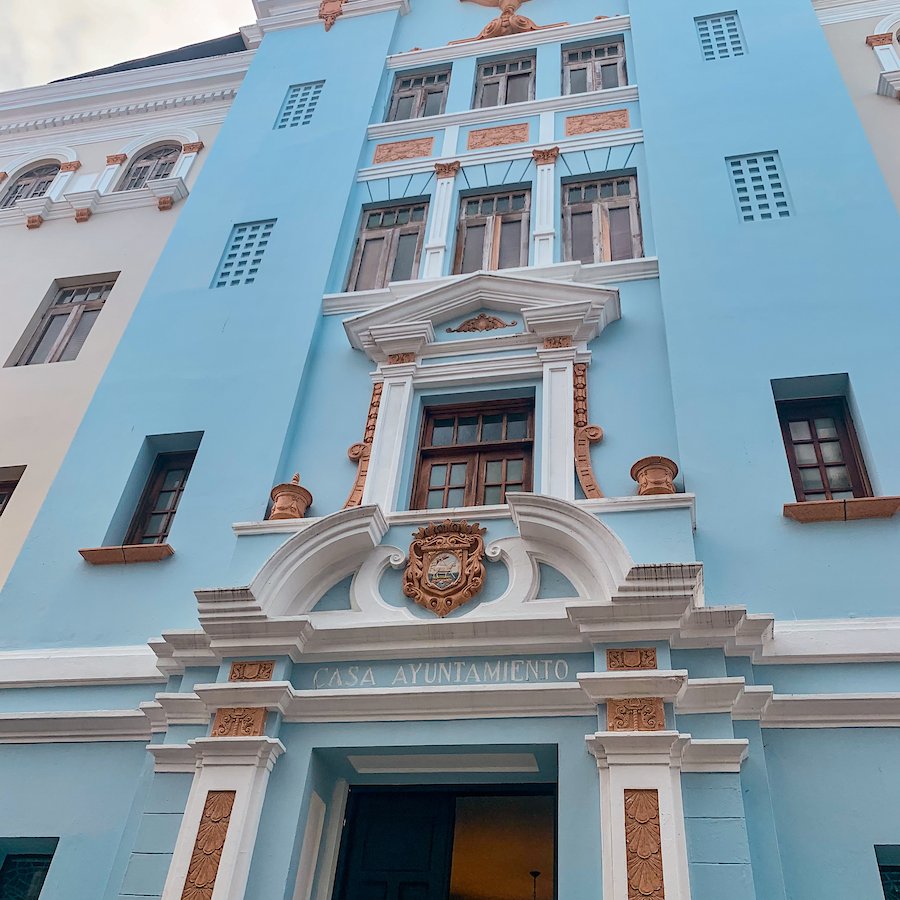
The façade at San Juan's town hall resembles old Madrid in Spain.
For lunch (or dinner), stop by Mercado La Carreta across Plaza de la Barandilla, where you’ll find an expansive menu that ranges from brunch items like pumpkin French Toast to some chuletas fritas (deep-fried pork chops) and arroz mamposteao.
After you eat, you can continue your building exploration with sightings of places like the Palacio Arzobispal, a set of houses purchased by bishop Sebastián Pizarro in 1737 and that he remodeled with time, giving it its current appearances. The building, which now houses a historical archive, is the perfect example of constructions pushed together in the walled city. And, while in San Juan, pass by the Antiguo Seminario Conciliar to peek at their chapel and dome, impressive structures that date back to the 1830s and that is now home to the Centro de Estudios Avanzados de Puerto Rico y el Caribe, a university founded by Mr. Alegría (yes, Jan D’Esopo’s consultant).
If you haven’t passed by it already, make your way to El Capitolio, which resembles neoclassical revival-style architecture built between 1925 and 1929. And, for modern and elegant sightings, stroll down the Paseo de la Princesa promenade overlooking the bay.
Other places to check out include the iconic Hotel El Convento, which you can tell that before becoming a stunning hotel, it used to be a nun convent by the mid-1800s. The Plaza de Armas (built-in 1521) served as the military ground for soldiers to depart to protect the city. Right across from it is the Casa Alcaldía or City Hall, which Madrid’s old town hall inspired the original façade in the early 1600s. The glass windows inside are a show on their own, so be sure to step inside and take pictures.
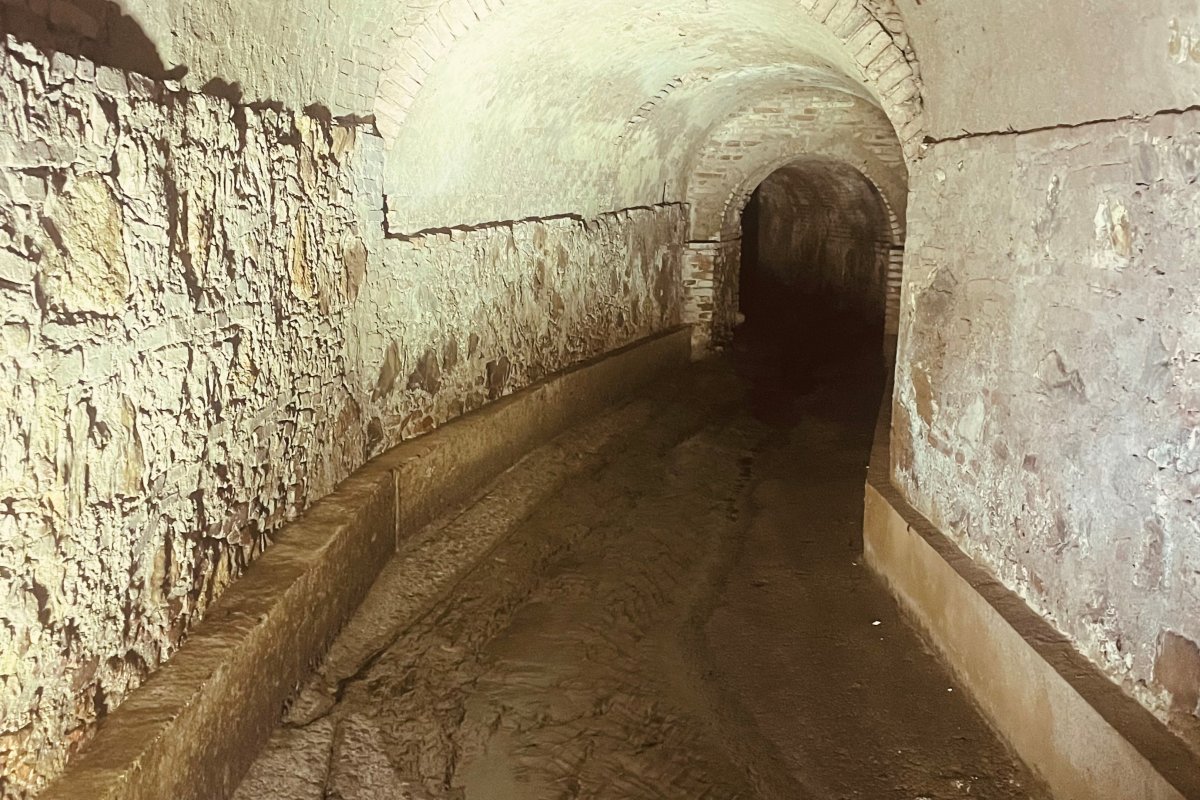
The San Germán tunnels are the town's best-kept secret.
Day Three: San Germán Is the Town of Towns
You’ve already visited San Juan, the Island’s oldest city (which you’ll later find out was a technicality), but where you’ll really enjoy ancient architecture and influences from all over the world is in Puerto Rico’s oldest town: San Germán.
A quick but necessary stop to understand Puerto Rico’s history through its buildings is this southern town, known as the “founder of 23 towns.” Although San Germán did not establish any other city, people that lived in the area which wanted to separate from the already established municipality were granted autonomy. Thus the towns of Ponce, Lajas, Maricao, Adjuntas, and many more were born.
As soon as you arrive, you’ll be greeted by Porta Coeli, a now religious museum that used to be a convent and church back in 1609. The entrance sits atop a grand staircase which is a spectacle on its own. Once inside, you’ll see wooden saints, hand-painted tiles with bible verses, the choir’s lodge, and many other religious memorabilia from yesteryear. From its door, you can overlook the Plaza Francisco Mariano Quiñones (which is two plazas in one), and across from it, a more “modern” (depends on your definition of modern) church built in 1688, Iglesia San Germán de Auxerre. You’ll see 18th-century wood carvings, impressive archways, and centuries-old catholic imagery all around the premises.
And, as you walk by the streets of San Germán, you must be aware of the magic and architectural gem that lies beneath the city. As you step closer to each building, keep in mind you’re walking at the top of an old tunnel system made of bricks and vaults that remain hidden under the restored streets and spectacular mansions in the center of this 400-year-old town. Although these tunnels are a recognized historical monument today, many sangermeños who live on some of their vaults only know them based on speculation, myths, and legends. So, call ahead of your visit and book a tour with the town’s tourism director for a special treat and history lesson underground.
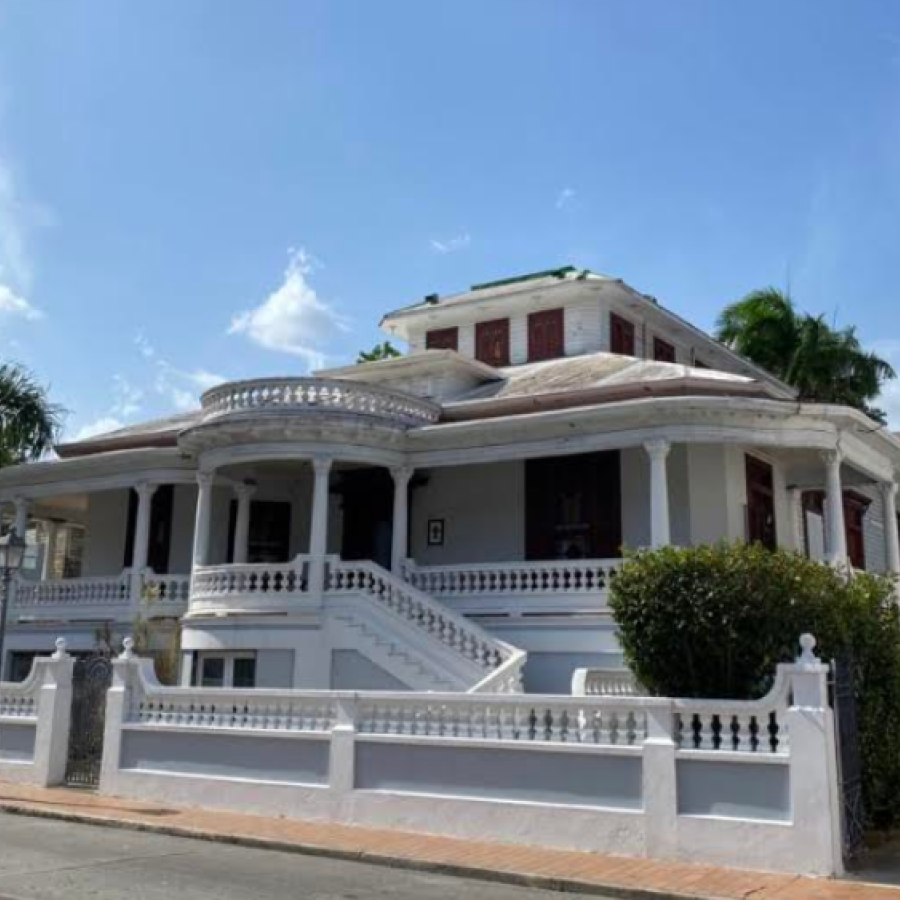
San Germans iconic houses show creole and French influences.
Once you’re done touring the tunnels (you will need to bring lots of water, it’s hot down there), keep strolling the streets above. You’ll encounter houses like the Ramírez Roggio House, known formerly as the Kindy house, a notable example of Creole Neoclassical style. The regal masonry was fully restored by 1970, and it’s iconic because of its double Tuscan columns and striking stained glass windows.
When you walk towards the Juan Ortiz Perichi house, dubbed as one of the most beautiful houses ever built in Puerto Rico, you’ll notice the Moorish influence and creole style it has. An imposing concrete fence with an iron gate separates the sidewalk house, accessed by a wide and comfortable staircase. An expansive balcony bordering the entire front and to the right and left sides of the house contains 20 columns that support the vaulted ceiling. The house was built with fine willow woods, brought from Louisiana and combined with others from the country. It has two huge cisterns and still uses the original electrification system.
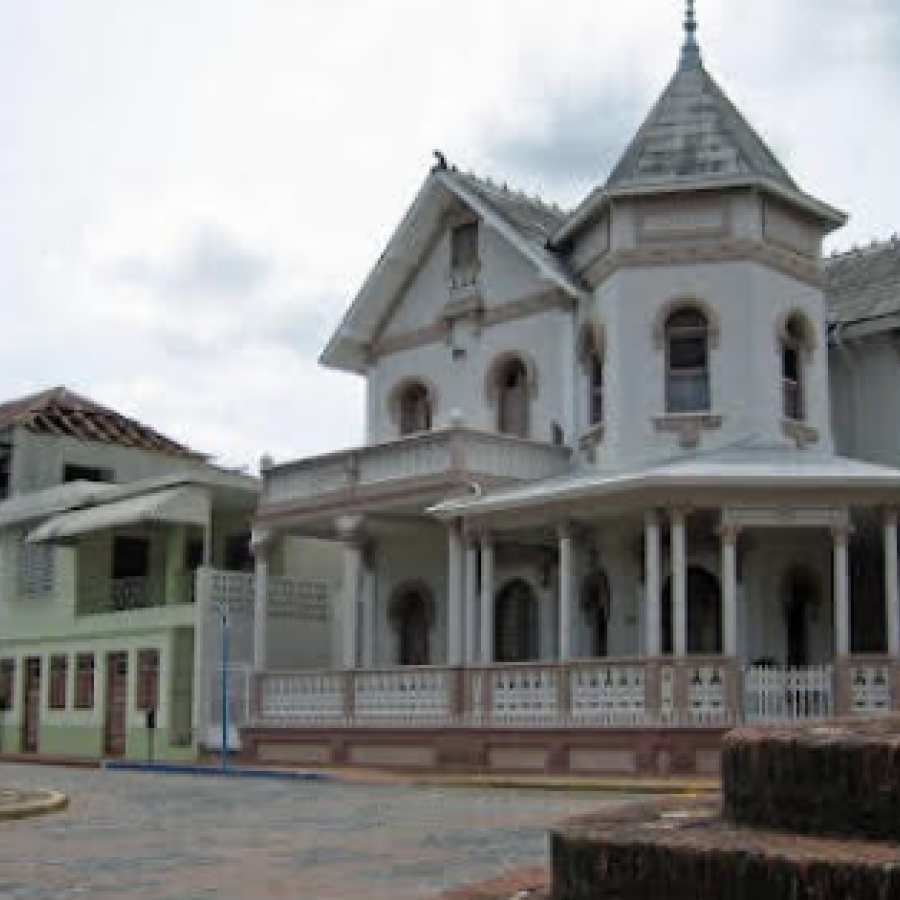
Morales Marco house in San German.
Another house you’ll notice just at the foot of Porta Coeli is the Morales Marco House. This property, built-in 1915, is the perfect example of the Queen Ana style and still keeps the original ceilings made of brass. The balcony railing and the terrace are supported by Ionic and Doric style columns, giving the structure elegance.
Nearby at the Casa de Lola Rodríguez de Tió Museum, visitors can explore a recreation of the home of one of the town’s most famous and accomplished families, where items like antique furniture and housewares, important letters, and historic documents are on view.
And, if the house tours don't have you beat, you can visit the Museo de la Historia de San Germán. This small historic bank houses a series of small galleries depicting the town's importance, from Taíno artifacts to sports memorabilia (San Germán is big on basketball). While most of the exhibits are in Spanish, an English-language video explains how San Germán played a vital role in the development of Puerto Rico.
Just across the street from it is the Museo Farmacia La Botica, a structure built in 1887 that recreates the 19th-century pharmacies and is adorned with original artifacts and details from microscopes to jars and an original coca-cola machine.
When you get hungry, all you have to do is pass by Porticos 1606, a criollo cuisine restaurant ready to serve you elevated versions of staple dishes like arroz con gandules y pasteles with some lechón, Jamaican-style meatballs, codfish croquets, yuca al mojo with salmon, and more.
After your history itch has been scratched in San Germán, head down to the nearby town of Ponce, where you can book a night or two at hotels like the Ponce Plaza Hotel, the Aloft Ponce, the Fox Hotel, and many others around.
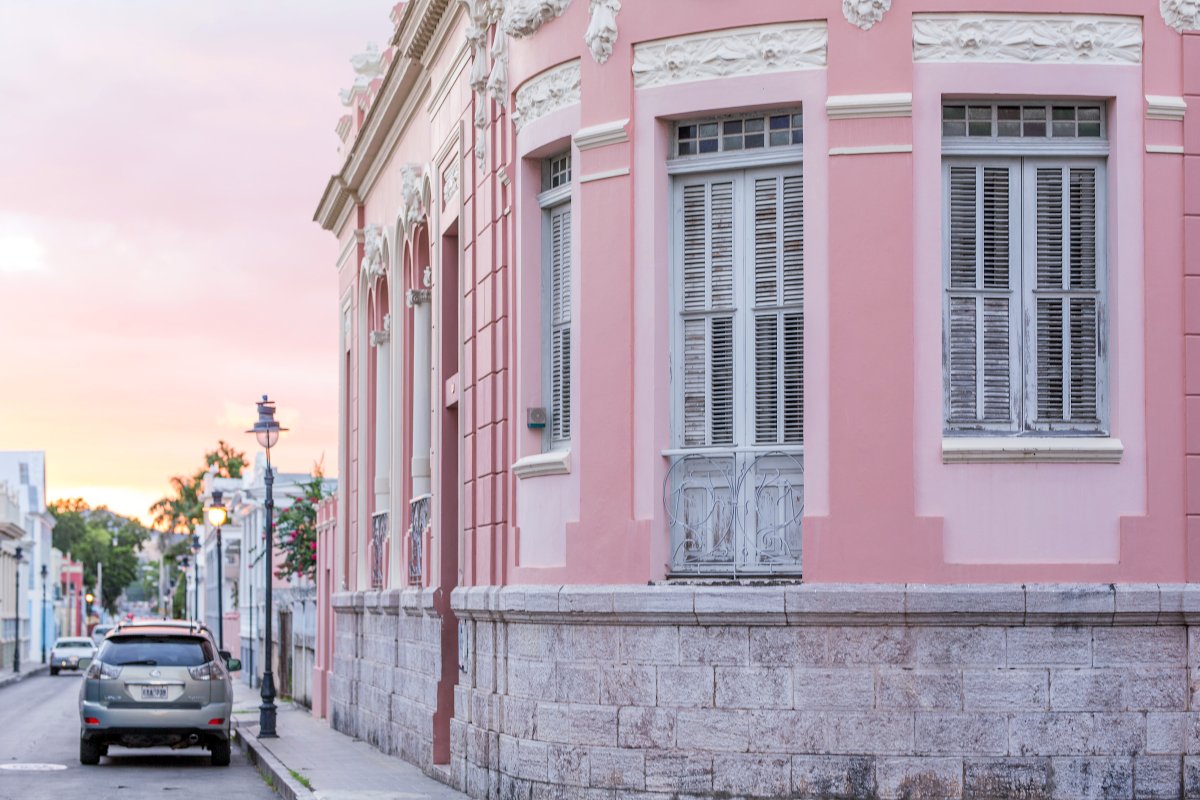
The town of Ponce is known as the “Pearl of the South.”
Day four: Ponce, Art Deco All Around!
Last day of touring, and you saved Art Deco in Ponce for last. This southern town is rich in culture, history, architecture, and overall vibrancy, and as soon as you arrive, you'll get a glimpse of the magnificent buildings. However, did you notice all buildings look like their corners have been cut off?
That is representative of the art nouveau and neoclassical style that is still prominent in the town. However, starting at Plaza las Delicias, the most emblematic building is the Parque de Bombas, a Gothic Victorian-style fire station turned museum that carries the red and black colors representing Ponce.
But, if you venture off the town's square, you'll notice the most famous house in Ponce, the Residencia Armstrong-Poventud. This historic building that sits across the city's cathedral is collectively known as Ponce Creole. It is registered as a National Historical Place, which now houses a museum managed by the Puerto Rican Culture Institute. Manuel Domenech designed and built the house, one of the Island's most distinguished architects of the late 19th and early 20th centuries.
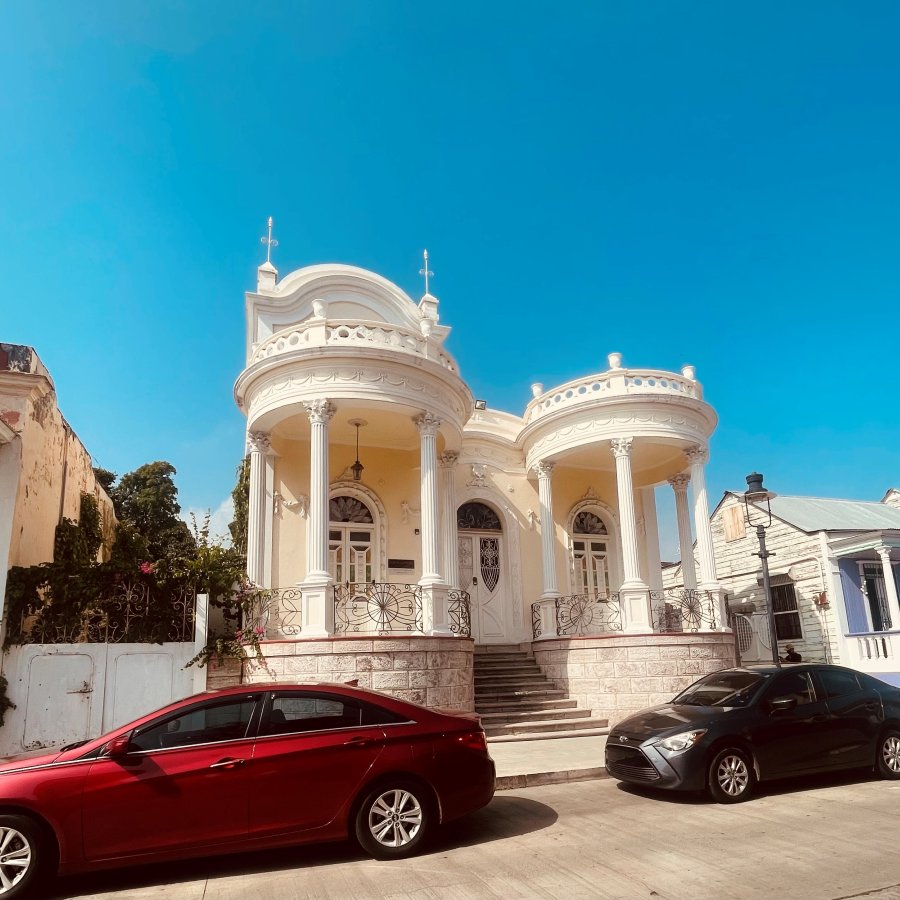
You can ask for a tour of the house through Isla Caribe.
The Virgilio Monsanto Méndez home is another house that will catch your eye while walking around town, especially if you tour with the lovely people of Isla Caribe tours. This house was designed by the engineer Blas Silva Boucher in 1912 for his spiritual advisor: Prudencia Ubides Aponte, wife of the industrialist Federico Fond Delord. Prudencia was a medium at the Centro Lumen de Ponce. The couple lived in the house until 1934, the year that Don Federico Fond died. You can see the initials of these first owners, Prudencia Ubides (PU) and Federico Fond (FF), on the balconies that give the house the shape of a cake at the entrance. The home is located on Castillo Street, which enters Salud y Virtud Street. Since 1987 the residence has been on the National Register of Historic Places. One of its last owners was the Architect Virgilio Monsanto. For this reason, it is known today as the Monsanto House.
If you keep walking around Ponce, you'll notice structures like la Plaza del Mercado and the Old Spanish Military Hospital of Ponce. This last one is a historic building in Ponce that dates from 1896 or 1897 and was designed by the Royal Corps of Engineers of Spain. The architecture consists of a neoclassical style. It preserves architectural importance since it is the only one-story building of this style that remains in Ponce and is one of the best examples on the Island. Completed in 1897, the year before the Spanish American War of 1898, this building was the last major construction carried out by the Spanish Government in America. From 1905 to the mid-1970s, the structure served as the Ponce Asylum for the Blind. It is currently abandoned.
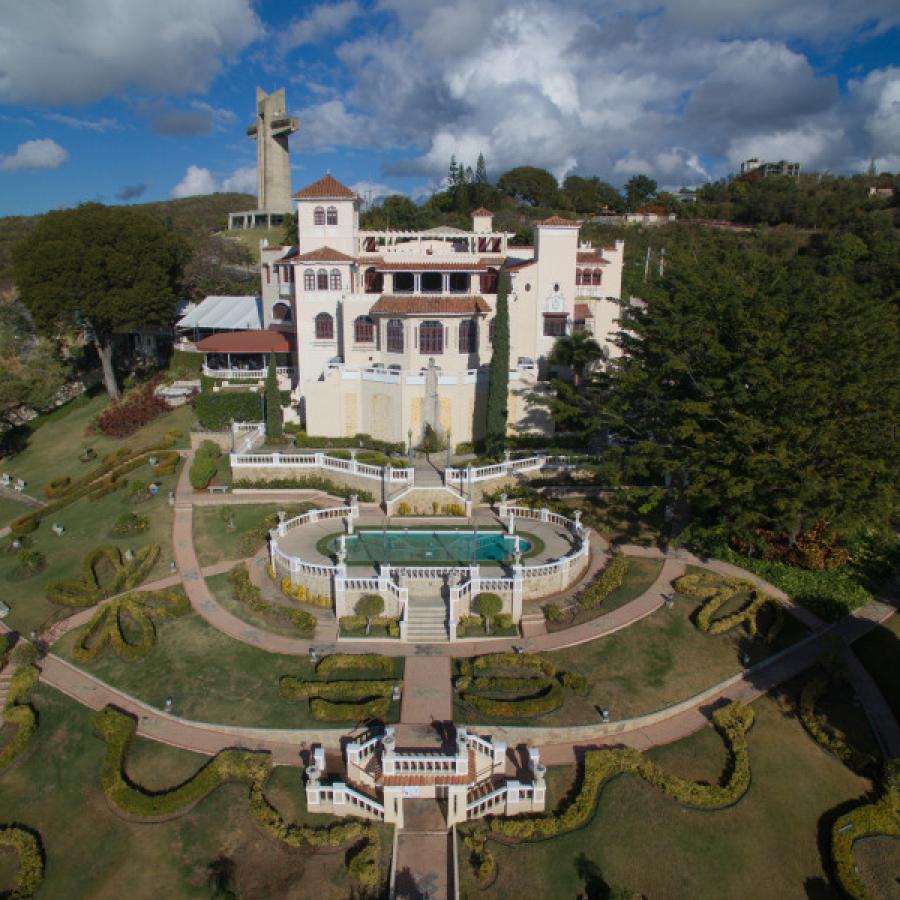
The Castillo Serrallés Museum is a 1930s Spanish Revival-style home built by the Serrallés family of the famous DonQ rum.
And no tour of Ponce's architecture is complete without visiting the astonishing and emblematic estate of Castillo Serrallés. The 1930s structure is the former estate of the Serrallés family, prominently known for their Don Q distillery. On a guided tour of the museum, you can appreciate the ornate architecture, manicured gardens, and lavish swimming pool, as well as learn about how the family lived and grew their business.
Keep going down the same route across the hill behind the Serrallés Castle, and you'll find the imposing Cruceta del Vigía, a high tower located on a hill overlooking the whole city. The Cruceta was built in the 19th century when the Island was under Spanish rule and was used to monitor and alert of possible pirate attacks or the arrival of commercial ships.
Dinner options for you in Ponce must include El Rastro, an eclectic new spot where you can taste not only local cuisine but elevated Asian dishes and many original creations.
After hours, and before getting a good night's to conclude your vacation, be sure to roam around the plaza, where you'll find plenty of businesses nuzzling with the town's cultural nightlife. Spots like The Fox Hotel and Utopía can serve as your starting points to finish off your night.
